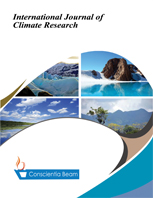Variations of Atmospheric Boundary Layer Stability Conditions Over Climate Belts in Nigeria
DOI:
https://doi.org/10.18488/journal.112.2018.31.1.9Abstract
This study examined the variation of atmospheric stability conditions in Nigeria’s climate belts using the Pasquill-Gifford (PG) technique. Surface meteorological data (2010-2015) from Era-Interim platform were used. Results show that across climate belts in Nigeria unstable conditions increased from the coast of Port Harcourt (tropical wet climate) to Kano (tropical continental climate) in the northern part of Nigeria. There is a revered trend for the neutral conditions. It is also observed that stable atmospheric stability conditions are slightly higher in the tropical continental climate and the semi-arid zone than the coastal zone. However the climate of Nigeria is dominated by the unstable atmospheric conditions. Very stable atmospheric conditions (stability class F) prevailed during the hours of the dawn for most of the seasons in the coastal areas while less stable atmospheric conditions (stability class E) prevailed in the semi-arid region of Nigeria. During the day, the boundary layer atmosphere is slightly unstable in the coastal areas and moderately unstable in the semi-arid belt. However, it indicates otherwise during transition periods. The implication of these atmospheric conditions across the various locations especially for the coastal city of Port Harcourt is that uncontrolled emissions will be constrained at ground level during the night due to subsidence inversion triggered by the very stable condition of the boundary layer. This will create health problems for boundary-layer dwellers exposed to severe air pollution episodes. Policy makers should ensure that emission reduction techniques are engaged by potential emitters sited near sensitive receptors in cities such as Port Harcourt.

